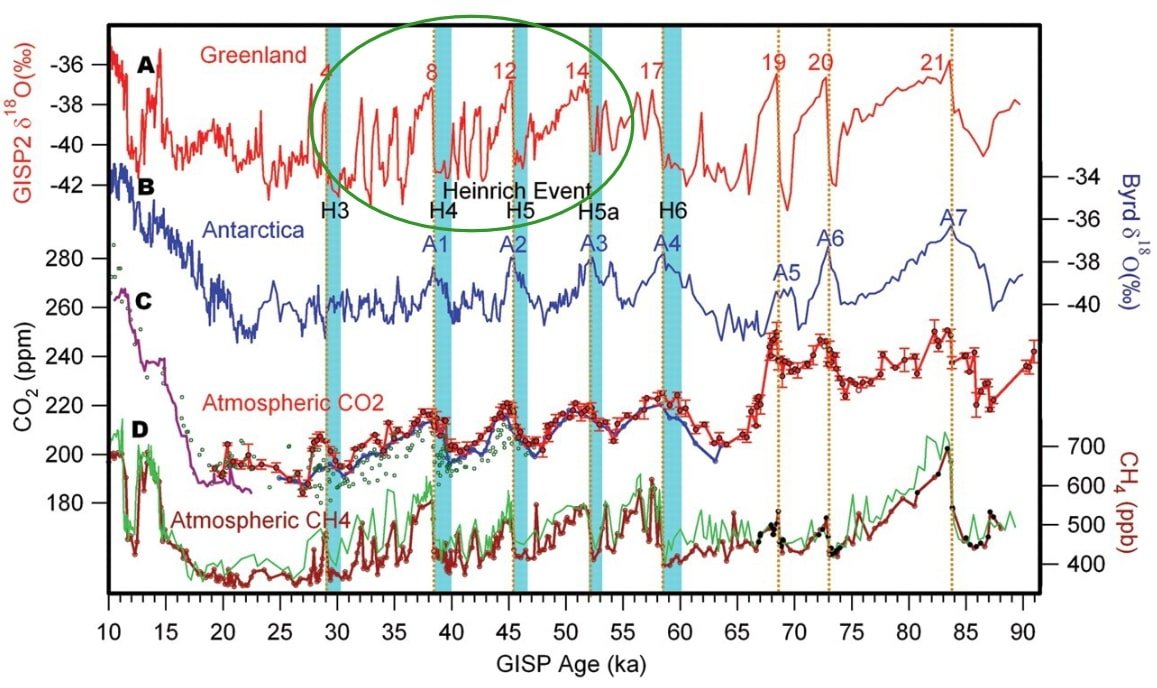Rapid Climate Change Is Not Unique to the Present
/Rapid climate change, such as the accelerated warming of the past 40 years, is not a new phenomenon. During the last ice age, which spanned the period from about 115,000 to 11,000 years ago, temperatures in Greenland rose abruptly and fell again at least 25 times. Corresponding temperature swings occurred in Antarctica too, although they were less pronounced than those in Greenland.
The striking but fleeting bursts of heat are known as Dansgaard–Oeschger (D-O) events, named after palaeoclimatologists Willi Dansgaard and Hans Oeschger who examined ice cores obtained by deep drilling the Greenland ice sheet. What they found was a series of rapid climate fluctuations, when the icebound earth suddenly warmed to near-interglacial conditions over just a few decades, only to gradually cool back down to frigid ice-age temperatures.
Ice-core data from Greenland and Antarctica are depicted in the figure below; two sets of measurements, recorded at different locations, are shown for each. The isotopic ratios of 18O to 16O, or δ18O, and 2H to 1H, or δ2H, in the cores are used as proxies for the past surface temperature in Greenland and Antarctica, respectively.
Multiple D-O events can be seen in the four sets of data, stronger in Greenland than Antarctica. The periodicity of successive events averages 1,470 years, which has led to the suggestion of a 1,500-year cycle of climate change associated with the sun.
Somewhat similar cyclicity has been observed during the present interglacial period or Holocene, with eight sudden temperature drops and recoveries, mirroring D-O temperature spurts, as illustrated by the thick black line in the next figure. Note that the horizontal timescale runs forward, compared to backward in the previous (and following) figure.
These so-called Bond events were identified by geologist Gerard Bond and his colleagues, who used drift ice measured in deep-sea sediment cores, and δ18O as a temperature proxy, to study ancient climate change. The deep-sea cores contain glacial debris rafted into the oceans by icebergs, and then dropped onto the sea floor as the icebergs melted. The volume of glacial debris was largest, and it was carried farthest out to sea, when temperatures were lowest.
Another set of distinctive, abrupt events during the latter part of the last ice age were Heinrich events, which are related to both D-O events and Bond cycles. Five of the six or more Heinrich events are shown in the following figure, where the red line represents Greenland ice-core δ18O data, and some of the many D-O events are marked; the figure also includes Antarctic δ18O data, together with ice-age CO2 and CH4 levels.
As you can see, Heinrich events represent the cooling portion of certain D-O events. Although the origins of both are debated, they are thought likely to be associated with an increase in icebergs discharged from the massive Laurentide ice sheet which covered most of Canada and the northern U.S. Just as with Bond events, Heinrich and D-O events left a signature on the ocean floor, in this case in the form of large rocks eroded by glaciers and dropped by melting icebergs.
The melting icebergs would have also disgorged enormous quantities of freshwater into the Labrador Sea. One hypothesis is that this vast influx of freshwater disrupted the deep-ocean thermohaline circulation (shown below) by lowering ocean salinity, which in turn suppressed deepwater formation and reduced the thermohaline circulation.
Since the thermohaline circulation plays an important role in transporting heat northward, a slowdown would have caused the North Atlantic to cool, leading to a Heinrich event. Later, as the supply of freshwater decreased, ocean salinity and deepwater formation would have increased again, resulting in the rapid warming of a D-O event.
However, this is but one of several possible explanations. The proposed freshwater increase and reduced deepwater formation during D-O events could have resulted from changes in wind and rainfall patterns in the Northern Hemisphere, or the expansion of Arctic sea ice, rather than melting icebergs.
In 2021, an international team of climate researchers concluded that when certain parts of the ice-age climate system changed abruptly, other parts of the system followed like a series of dominoes toppling in succession. But to their surprise, neither the rate of change nor the order of the processes were the same from one event to the other.
Using data from two Greenland ice cores, the researchers discovered that changes in ocean currents, sea ice and wind patterns were so closely intertwined that they likely triggered and reinforced each other in bringing about the abrupt climate changes of D-O and Heinrich events.
While there’s clearly no connection between ice-age D-O events and today’s accelerated warming, this research and the very existence of such events show that the underlying causes of rapid climate change can be elusive.
Next: Challenges to the CO2 Global Warming Hypothesis: (11) Global Warming Is Driven by Oceanic Seismic Activity, Not CO2








